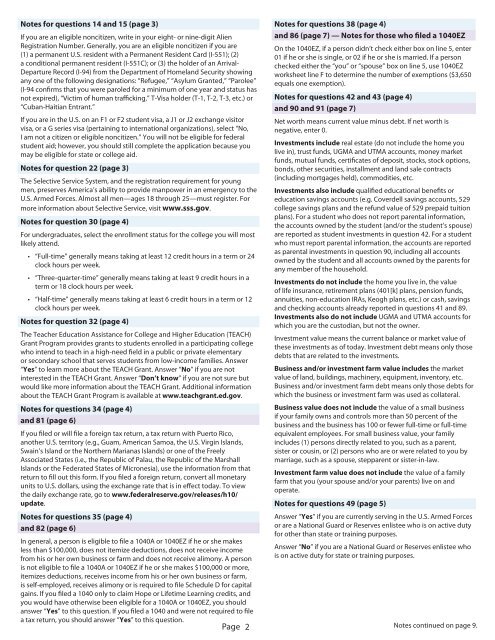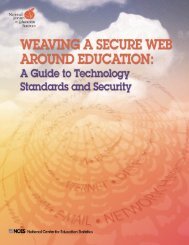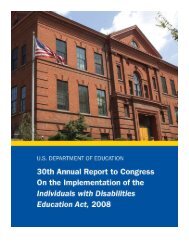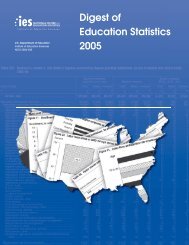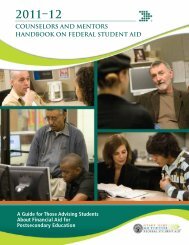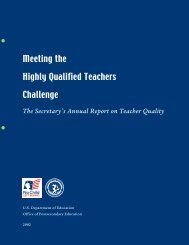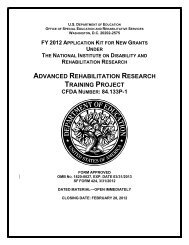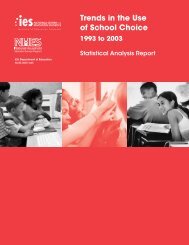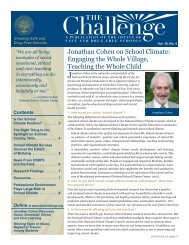FAFSA 10-11 (en) Form 2009-12-28.indd
FAFSA 10-11 (en) Form 2009-12-28.indd
FAFSA 10-11 (en) Form 2009-12-28.indd
You also want an ePaper? Increase the reach of your titles
YUMPU automatically turns print PDFs into web optimized ePapers that Google loves.
Notes for questions 14 and 15 (page 3)If you are an eligible noncitiz<strong>en</strong>, write in your eight- or nine-digit Ali<strong>en</strong>Registration Number. G<strong>en</strong>erally, you are an eligible noncitiz<strong>en</strong> if you are(1) a perman<strong>en</strong>t U.S. resid<strong>en</strong>t with a Perman<strong>en</strong>t Resid<strong>en</strong>t Card (I-551); (2)a conditional perman<strong>en</strong>t resid<strong>en</strong>t (I-551C); or (3) the holder of an Arrival-Departure Record (I-94) from the Departm<strong>en</strong>t of Homeland Security showingany one of the following designations: “Refugee,” “Asylum Granted,” “Parolee”(I-94 confirms that you were paroled for a minimum of one year and status hasnot expired), “Victim of human trafficking,” T-Visa holder (T-1, T-2, T-3, etc.) or“Cuban-Haitian Entrant.”If you are in the U.S. on an F1 or F2 stud<strong>en</strong>t visa, a J1 or J2 exchange visitorvisa, or a G series visa (pertaining to international organizations), select “No,I am not a citiz<strong>en</strong> or eligible noncitiz<strong>en</strong>.” You will not be eligible for federalstud<strong>en</strong>t aid; however, you should still complete the application because youmay be eligible for state or college aid.Notes for question 22 (page 3)The Selective Service System, and the registration requirem<strong>en</strong>t for youngm<strong>en</strong>, preserves America’s ability to provide manpower in an emerg<strong>en</strong>cy to theU.S. Armed Forces. Almost all m<strong>en</strong>—ages 18 through 25—must register. <strong>Form</strong>ore information about Selective Service, visit www.sss.gov.Notes for question 30 (page 4)For undergraduates, select the <strong>en</strong>rollm<strong>en</strong>t status for the college you will mostlikely att<strong>en</strong>d.• “Full-time” g<strong>en</strong>erally means taking at least <strong>12</strong> credit hours in a term or 24clock hours per week.• “Three-quarter-time” g<strong>en</strong>erally means taking at least 9 credit hours in aterm or 18 clock hours per week.• “Half-time” g<strong>en</strong>erally means taking at least 6 credit hours in a term or <strong>12</strong>clock hours per week.Notes for question 32 (page 4)The Teacher Education Assistance for College and Higher Education (TEACH)Grant Program provides grants to stud<strong>en</strong>ts <strong>en</strong>rolled in a participating collegewho int<strong>en</strong>d to teach in a high-need field in a public or private elem<strong>en</strong>taryor secondary school that serves stud<strong>en</strong>ts from low-income families. Answer“Yes” to learn more about the TEACH Grant. Answer “No” if you are notinterested in the TEACH Grant. Answer “Don’t know” if you are not sure butwould like more information about the TEACH Grant. Additional informationabout the TEACH Grant Program is available at www.teachgrant.ed.gov.Notes for questions 34 (page 4)and 81 (page 6)If you filed or will file a foreign tax return, a tax return with Puerto Rico,another U.S. territory (e.g., Guam, American Samoa, the U.S. Virgin Islands,Swain’s Island or the Northern Marianas Islands) or one of the FreelyAssociated States (i.e., the Republic of Palau, the Republic of the MarshallIslands or the Federated States of Micronesia), use the information from thatreturn to fill out this form. If you filed a foreign return, convert all monetaryunits to U.S. dollars, using the exchange rate that is in effect today. To viewthe daily exchange rate, go to www.federalreserve.gov/releases/h<strong>10</strong>/update.Notes for questions 35 (page 4)and 82 (page 6)In g<strong>en</strong>eral, a person is eligible to file a <strong>10</strong>40A or <strong>10</strong>40EZ if he or she makesless than $<strong>10</strong>0,000, does not itemize deductions, does not receive incomefrom his or her own business or farm and does not receive alimony. A personis not eligible to file a <strong>10</strong>40A or <strong>10</strong>40EZ if he or she makes $<strong>10</strong>0,000 or more,itemizes deductions, receives income from his or her own business or farm,is self-employed, receives alimony or is required to file Schedule D for capitalgains. If you filed a <strong>10</strong>40 only to claim Hope or Lifetime Learning credits, andyou would have otherwise be<strong>en</strong> eligible for a <strong>10</strong>40A or <strong>10</strong>40EZ, you shouldanswer “Yes” to this question. If you filed a <strong>10</strong>40 and were not required to filea tax return, you should answer “Yes” to this question.Notes for questions 38 (page 4)and 86 (page 7) — Notes for those who filed a <strong>10</strong>40EZOn the <strong>10</strong>40EZ, if a person didn’t check either box on line 5, <strong>en</strong>ter01 if he or she is single, or 02 if he or she is married. If a personchecked either the “you” or “spouse” box on line 5, use <strong>10</strong>40EZworksheet line F to determine the number of exemptions ($3,650equals one exemption).Notes for questions 42 and 43 (page 4)and 90 and 91 (page 7)Net worth means curr<strong>en</strong>t value minus debt. If net worth isnegative, <strong>en</strong>ter 0.Investm<strong>en</strong>ts include real estate (do not include the home youlive in), trust funds, UGMA and UTMA accounts, money marketfunds, mutual funds, certificates of deposit, stocks, stock options,bonds, other securities, installm<strong>en</strong>t and land sale contracts(including mortgages held), commodities, etc.Investm<strong>en</strong>ts also include qualified educational b<strong>en</strong>efits oreducation savings accounts (e.g. Coverdell savings accounts, 529college savings plans and the refund value of 529 prepaid tuitionplans). For a stud<strong>en</strong>t who does not report par<strong>en</strong>tal information,the accounts owned by the stud<strong>en</strong>t (and/or the stud<strong>en</strong>t’s spouse)are reported as stud<strong>en</strong>t investm<strong>en</strong>ts in question 42. For a stud<strong>en</strong>twho must report par<strong>en</strong>tal information, the accounts are reportedas par<strong>en</strong>tal investm<strong>en</strong>ts in question 90, including all accountsowned by the stud<strong>en</strong>t and all accounts owned by the par<strong>en</strong>ts forany member of the household.Investm<strong>en</strong>ts do not include the home you live in, the valueof life insurance, retirem<strong>en</strong>t plans (401[k] plans, p<strong>en</strong>sion funds,annuities, non-education IRAs, Keogh plans, etc.) or cash, savingsand checking accounts already reported in questions 41 and 89.Investm<strong>en</strong>ts also do not include UGMA and UTMA accounts forwhich you are the custodian, but not the owner.Investm<strong>en</strong>t value means the curr<strong>en</strong>t balance or market value ofthese investm<strong>en</strong>ts as of today. Investm<strong>en</strong>t debt means only thosedebts that are related to the investm<strong>en</strong>ts.Business and/or investm<strong>en</strong>t farm value includes the marketvalue of land, buildings, machinery, equipm<strong>en</strong>t, inv<strong>en</strong>tory, etc.Business and/or investm<strong>en</strong>t farm debt means only those debts forwhich the business or investm<strong>en</strong>t farm was used as collateral.Business value does not include the value of a small businessif your family owns and controls more than 50 perc<strong>en</strong>t of thebusiness and the business has <strong>10</strong>0 or fewer full-time or full-timeequival<strong>en</strong>t employees. For small business value, your familyincludes (1) persons directly related to you, such as a par<strong>en</strong>t,sister or cousin, or (2) persons who are or were related to you bymarriage, such as a spouse, steppar<strong>en</strong>t or sister-in-law.Investm<strong>en</strong>t farm value does not include the value of a familyfarm that you (your spouse and/or your par<strong>en</strong>ts) live on andoperate.Notes for questions 49 (page 5)Answer “Yes” if you are curr<strong>en</strong>tly serving in the U.S. Armed Forcesor are a National Guard or Reserves <strong>en</strong>listee who is on active dutyfor other than state or training purposes.Answer “No” if you are a National Guard or Reserves <strong>en</strong>listee whois on active duty for state or training purposes.Page 2 Notes continued on page 9.


